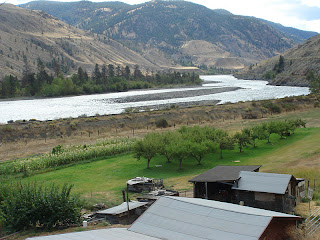Cache Creek to Princeton , Thompson Canyon Fraser Canyon
If I ever thought the Rockies just had snow capped mountain ranges and nothing else, I now know better. As I mentioned before there are several north-south running ranges, starting from the West, which are all very different, as well as the valleys separating them. Thompson Canyon
Setting out from Cache Creek the first stop is in Ashcroft. A local man dressed as a cowboy, in hat, checked shirt and jeans, starts talking to us in front of a bakery. The smells from the shop are mouth-watering and apparently we have come to the best known address in town, famous for its cinnamon buns which are huge, sticky, sweet and spicy at the same time. The tiny café in front of the counter is packed with locals who come to exchange the news while enjoying a coffee and a bun. We join them and they all want to know where we come from and where we are heading to. The “cowboy” knows a lot about the area, and points out the remains of some irrigation flumes to us. He tells us about the history of the place, why the flanks of the mountains have such peculiar folds, reminding me of the folded skin of a huge spaniel. He also tells us a lot about the valleys and towns we visited yesterday. And a Canadian, German by birth and an immigrant, tells my companions everything they want to know about the RV he has rented, one of the hundreds of motor homes we have seen so far, crossing through Canada.
 |
| Portuguese fruit farm |
Along the Thompson Canyon Portugal
We drive on through the Thompson Canyon Fraser River
At Lytton the two rivers merge, the different streams clearly visible where the rivers meet, the Fraser a milky white, the Thompson clear.
The Fraser Canyon is deep, the steep mountain sides covered with spruce and pine. The rocks are different and made of a darker stone than along the Thompson Canyon Kamloops
Rocky Mountaineer
We have a picnic on a small secluded strip of land near a bridge across the Fraser River
Eventually we reach Hope where we turn East on route 3 leaving the canyon. After a coffee stop, we drive through Manning Provincial Park – rather green and not very spectacular after what we have seen so far, at east not from the road – to Princeton, a pleasant little town where we find a motel for the night. As this one has a fully equipped kitchen, we buy pizzas and tomatoes, enjoying a meal in our own apartment.







No comments:
Post a Comment